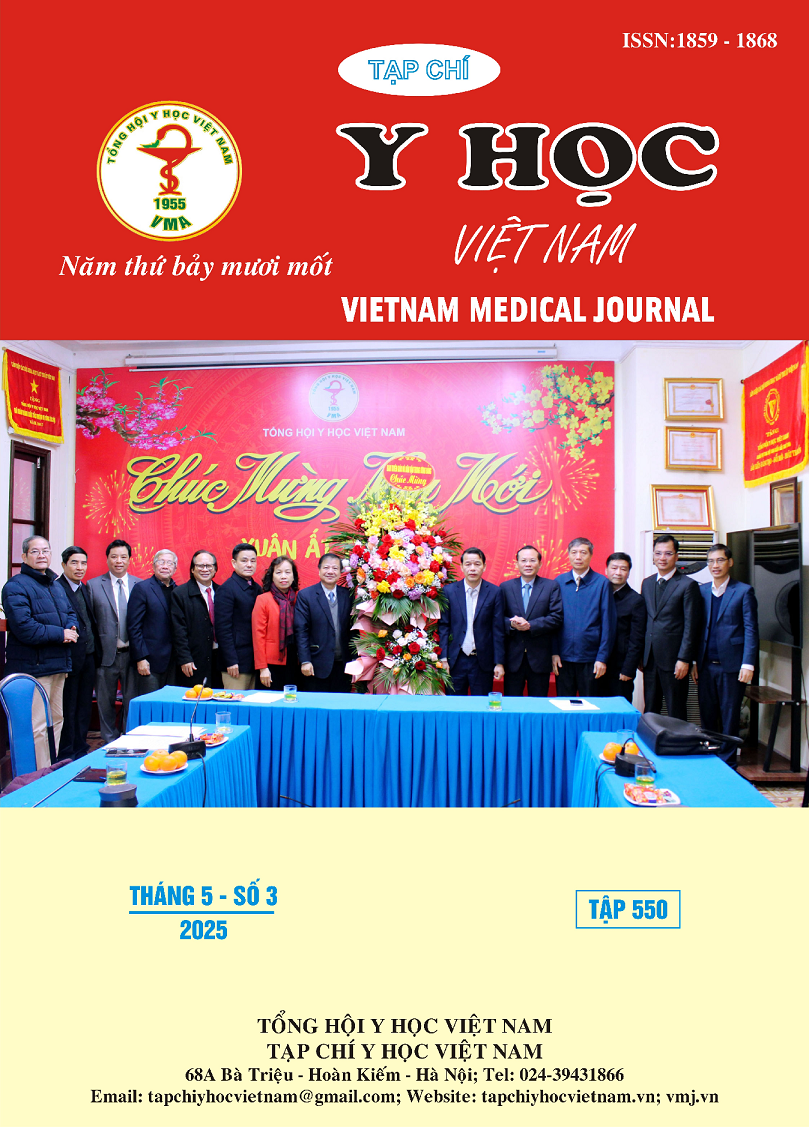CLINICAL AND IMAGING CHARACTERISTICS OF ABDOMINAL WALL ENDOMETRIOSIS IN PATIENTS TREATED WITH RADIOFREQUENCY ABLATION AT HANOI MEDICAL UNIVERSITY HOSPITAL
Main Article Content
Abstract
Objective: This study describes the clinical and imaging characteristics of patients with abdominal wall endometriosis (AWE) treated with radiofrequency ablation (RFA) at Hanoi Medical University Hospital. Subjects and Methods: A retrospective study was conducted on 17 patients with 28 AWE lesions treated with ultrasound-guided RFA from November 2023 to March 2025. Patients were diagnosed based on clinical evaluation, imaging, or pathological confirmation through lesion biopsy. Results: The mean patient age was 35.53 ± 4.99 years. The main clinical symptoms were palpable mass (88.2%) and cyclic abdominal pain (76.5%). All patients had a history of cesarean section. The mean latency period from the last cesarean section to symptom onset was 2.69 ± 2.25 years. Ultrasound features: All lesions were hypoechoic and heterogeneous (100%), with poorly defined margins (84.6%), solid appearance (73.1%), and vascular signals on Doppler ultrasound (41.2%). Lesion locations included the abdominal wall muscle (23.1%), subcutaneous fat (30.8%), and both subcutaneous fat and abdominal wall muscle (46.1%). MRI features: The lesions showed high signal intensity on T1-weighted images (T1W) compared to muscle (33.3%), isointense signal on T1W (40.7%), high signal intensity on T2-weighted images (T2W) (51.9%), mixed signal on T2W (40.7%), high signal on T1-fat saturation (T1FS) (74.1%), diffusion restriction on DWI/ADC (25.9%), and strong post-contrast enhancement (92.6%). Additionally, 11.8% of patients had ovarian endometriotic cysts. Conclusion: Abdominal wall endometriosis commonly occurs in reproductive-age women with a history of cesarean section. Cyclic abdominal pain and a palpable mass are suggestive clinical signs. Ultrasound and MRI help determine lesion characteristics, quantity, anatomical relationships, and contrast enhancement patterns, aiding in diagnosis and treatment planning.
Article Details
Keywords
abdominal wall endometriosis, ultrasound, magnetic resonance imaging
References
2. Bektaş H, Bilsel Y, Sari YS, Ersöz F, Koç O, Deniz M, et al. Abdominal wall endometrioma; a 10-year experience and brief review of the literature. J Surg Res. 2010 Nov;164(1):e77-81.
3. Benedetto C, Cacozza D, de Sousa Costa D, Coloma Cruz A, Tessmann Zomer M, Cosma S, et al. Abdominal wall endometriosis: Report of 83 cases. International Journal of Gynecology & Obstetrics. 2022;159(2):530–6.
4. Khan Z, Zanfagnin V, El-Nashar SA, Famuyide AO, Daftary GS, Hopkins MR. Risk Factors, Clinical Presentation, and Outcomes for Abdominal Wall Endometriosis. J Minim Invasive Gynecol. 2017;24(3):478–84.
5. Rindos NB, Mansuria S. Diagnosis and Management of Abdominal Wall Endometriosis: A Systematic Review and Clinical Recommendations. Obstetrical & Gynecological Survey. 2017 Feb;72(2):116.
6. Hensen JHJ, Van Breda Vriesman AC, Puylaert JBCM. Abdominal Wall Endometriosis: Clinical Presentation and Imaging Features with Emphasis on Sonography. American Journal of Roentgenology. 2006 Mar;186(3):616–20.
7. Solak A, Genç B, Yalaz S, Şahin N, Sezer TÖ, Solak İ. Abdominal Wall Endometrioma: Ultrasonographic Features and Correlation with Clinical Findings. Balkan Med J. 2013 Jun;30(2):155–60.
8. Yu CY, Perez-Reyes M, Brown JJ, Borrello JA. MR appearance of umbilical endometriosis. J Comput Assist Tomogr. 1994;18(2):269–71.


